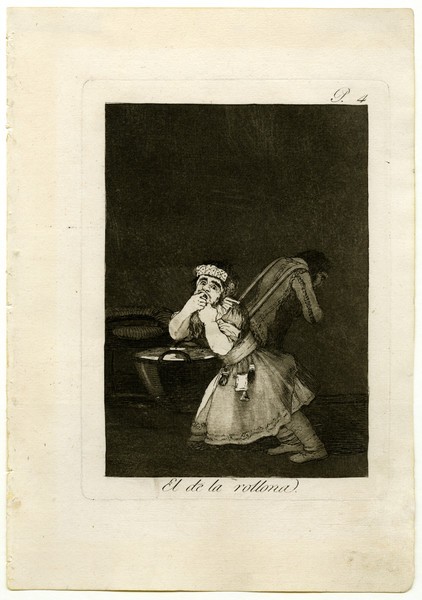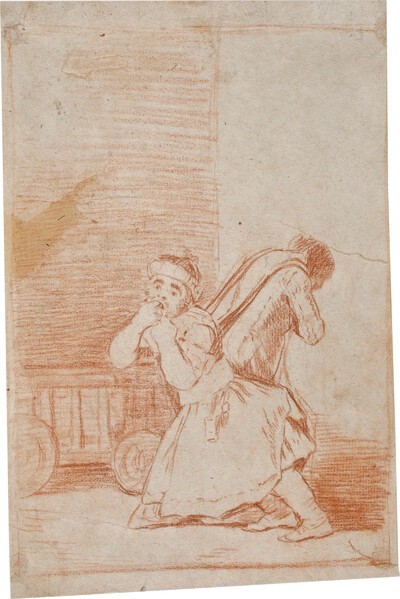- Cronología
- Ca. 1797 - 1799
- Dimensiones
- 209 x 157 mm
- Técnica y soporte
- Etching and burnished aquatint
- Reconocimiento de la autoría de Goya
- Undisputed work
- Ficha: realización/revisión
- 10 Nov 2010 / 29 May 2024
- Inventario
- 225
The one on the rollona (in the lower part)
P.4. (in the upper right-hand corner)
See Francisco de Goya y Lucientes, Painter.
There is a state proof that has manuscript in pen and ink, before the lettering, What a brutish man I am. In another proof Goya wrote the final title in pencil. Some stamps were thrown away in which the word "rollona" appeared with a y instead of an ll. Later the change was made and in the rest of the engravings the word appears written with an "ll".
A preparatory drawing is preserved in the Prado Museum.
In the centre of the image, Goya depicts an adult man wearing children's clothes, a chichonera and a girdle-belt. From the belt hang a badger, a shearing and the book of the Gospels, all of which are frequently used as amulets to ward off the evil eye. The figure's attitude reinforces his childish character, as he sucks one of his fingers. In the background, in the semi-darkness, we can make out the figure of a servant who pulls the child, whose whims and caprices he must be aware of.
The light focuses on the figure of the adult dressed as a child, whom he rescues from the darkness. It reveals his face and the position of his hands next to his mouth, as well as the belt from which the amulets hang. It also shows two objects in the background, a cauldron of food and a cushioned toilet, which allude to the character's main concerns.
Ayala's manuscript states of this image that "the children of the great gorge themselves on food, suck their thumbs and are always little boys, even with beards, and so they need footmen to carry them with walkers". The Prado Museum's own author points out that "negligence, tolerance and the same make children whimsical, obstinate, arrogant, greedy, pernicious and insufferable; they grow up to be grown-ups and are still children. Such is the Rollona". The one in the National Library, which best explains Goya's work, notes that "The children of the Greats are always brought up like little children, sucking their thumbs, gorging themselves on food, dragged along by their lackeys, full of superstitious sayings, even when they are already bearded".
The starting point for this image could be a folkloric motif that appears in the short plays of the 17th and early 18th centuries. Likewise, in the Treasury of the Castilian or Spanish Language of 1610, by Sebastián de Covarrubias (Toledo, 1539-1613), the proverb "el niño de la Rollona que tenía siete años y mamaba" (the Rollona's child who was seven years old and sucked) is referred to. Continuing with this proverb, the author says that "there are some boys who are so good that even though they are grown up, they do not know how to leave their mothers' laps; they turn out to be great fools or great vicious fools". The Rollona boy is also mentioned in the manuscript of proverbs compiled in 1627 by Gonzalo Correas (Jaraíz de la Vera [Cáceres], 1571-Salamanca, 1631), a professor of Greek and Hebrew at the University of Salamanca. This work remained unpublished until the end of the 18th century when it was taken up by the Royal Academy, which included some of the expressions noted by Correa in its Dictionary of the Castilian Language. In it, the child of the Rollona was defined as "a nickname for a "tocho" or "ronzero".
This print should be interpreted as a clear satire of the education received by the children of noble families or some members of the royal family. They were often treated in a manner that did not correspond to their true age in an attempt to prolong their childhood and were constantly and constantly assisted by servants and lackeys who suffered their whims. They were protected with amulets and their heads were filled with superstitions.
The plate, which is kept at the National Chalcography (no. 175), is in rather poor condition, with the aquatint and etching rather weakened.
-
Goya. Gemälde Zeichnungen. Graphik. TapisserienKunsthalle BaselBasle1953from January 23th to April 12th 1953cat. 196
-
Goya y el espíritu de la IlustraciónMuseo Nacional del PradoMadrid1988from October 6th to December 18th 1988. Exhibited also at Museum of Fine Arts, Boston, January 18th to March 26th 1989; The Metropolitan Museum of Art, Nueva York, May 9th to July 16th 1989, Madrid curator Manuela B. Mena Marqués, scientific directors Alfonso E. Pérez Sánchez and Eleanor A. Sayrecat. 41
-
Goya. La década de Los CaprichosMadrid1992organized by Real Academia de Bellas Artes de San Fernando sponsored by Fundación Central Hispano, Madrid, consultant editor Nigel Glendinnig. From October 26th 1992 to January 10th 1993cat. 49
-
Francisco de GoyaMuseo d'Arte ModernaLugano1996exhibition celebrated from September 22nd to November 17th.cat. 4, p.31
-
Francisco Goya. Sein leben im spiegel der graphik. Fuendetodos 1746-1828 Bordeaux. 1746-1996Galerie KornfeldBern1996from November 21st 1996 to January 1997cat. 10
-
Francisco Goya. Capricci, follie e disastri della guerraSan Donato Milanese2000Opere grafiche della Fondazione Antonio Mazzottacat. 4, p.18
-
Goya e la tradizione italianaFondazione Magnani RoccaMamiano di Traversetolo (Parma)2006consultant editors Fred Licht and Simona Tosini Pizzetti. From September 9th to December 3th 2006cat. 4, p.146
-
Goya. Opera graficaPinacoteca del Castello di San GiorgioLegnano2006exhibition celebrated from December 16th 2006 to April 1st 2007
-
Goya e ItaliaMuseo de ZaragozaZaragoza2008organized by the Fundación Goya en Aragóna, consultant editor Joan Sureda Pons. From June 1st to September 15th 2008cat. 319
-
Goya et la modernitéPinacothèque de ParisParís2013from October 11st 2013 to March 16th 2014cat. 140
-
Goya engravings and lithographs, vol. I y II.OxfordBruno Cassirer1964p.74, cat.39
-
Vie et ouvre de Francisco de GoyaParísOffice du livre1970p.176, cat. 457
-
La década de los Caprichos. Retratos 1792-1804MadridReal Academia de Bellas Artes de San Fernando1992pp.81-83, cat. 49
-
Catálogo de las estampas de Goya en la Biblioteca NacionalMadridMinisterio de Educación y Cultura, Biblioteca Nacional1996p.76, cat. 92
-
El libro de los caprichos: dos siglos de interpretaciones (1799-1999). Catálogo de los dibujos, pruebas de estado, láminas de cobre y estampas de la primera ediciónMadridMuseo Nacional del Prado1999pp.72-75
-
Francisco Goya. Los CaprichosBarcelonaEdiciones de la Central2011p.42
-
ParísPinacoteca de París2013p. 202
-
Goya. In the Norton Simon MuseumPasadenaNorton Simon Museum2016pp. 42-75

